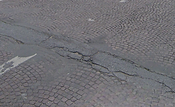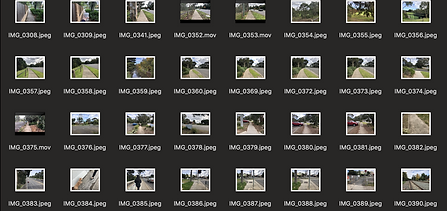Re-Walk
Re-Walk is three-part project that concerns my own experience and memory of being a tourist in Paris. By recreating some experiences digitally and physically, I am investigating what is lost, gained and untranslatable in the experience encountered through the two realms.
In the first part of this project, a walk from Louvre Museum to Notre Dame that I encountered during my visit to Paris is digitalised. By using google maps as a guide during that walk, I re-used it as a material platform to replicate this walk.
As Google maps allows for a virtual street view where the street view is pre-recorded and captured, the online space that we can travel through has physical characteristics to it that almost mimics physical reality.
Through this part of the project, the walking journey is recreated and major distinctions are distinguished by time, movement and perspectival experiences.
The second part of this project replicates the same walk however in Melbourne. By mapping out the route in a similar geographic orientation, I am able to draw parallels to the experience of the same path but in different countries.
Through this recreation of the walk, I mimicked the places I stopped for photos and videos in order to make the experience comparable. With this in mind, whilst I walked this route, I used Google Maps street view as an equivalent tool where I could draw parallels to my view of being two places at once: one in the physical world in Melbourne, and the other through the internet in Paris.
This third part of the project is similar to part II where it is replicating an experience that I encountered as a tourist in Paris. The site in this part is The Louvre Pyramids and recreated the tourist moment at Federation Square in Melbourne. This time however, I was "controlling" another person to visit that place for me. Through a set of instructions, a similar path around The Louvre Pyramids and Federation Square was performed with moments of observing, photographing and recording.
The imitation was experienced through another person's perspective, allowing for an alternate angle of exploration. I experienced it as a form of memory and documentation by someone else, similar to Google Maps.
Part I
Re-walking my route from Louvre Pyramids to Notre Dame through Google Maps street view
Movement and Distortion









Moving through Google Maps, it is evident that movement brings distortion in the view depicted. By recreating the walk through this digital platform, the viewers experiences time through the weather of the day depicted. Unlike physically walking, Google Maps allows the viewers to be thrusted into different frames, shortening the journey and in a way, fast-forwarding time. Google Maps also informed me of what street I was walking down as the street names are displayed on the road, with a smaller map on the corner showcasing a map, similarly to physically walking to a destination with google maps on your phone in hand.
With movement comes limitations on Google Maps as I was not able to fully replicate the walk as there was a specific route that Google Maps offered which was "walking" on the road instead of footpath. Although this restriction allowed me to "walk" the journey through a different perspective, it couldn't replicate and fulfil the sensorial aspects of experiencing the urban space.









Slowing Down
Travelling through the digital realm allows for the control of time. As time is not a limiting aspect on the internet unlike in the physical world where everything is constrained by the limit of time, one is able to pause, fast-forward and retrace their journey. This idea allows the digital tourist to slow down and stop to observe the smaller details and experience a place in a more sensorial fashion.
By re-walking the similar route in Paris through Google Maps, I was able to stop and really look around at the happenings in the moment. Although people's faces were blurred out and movements were distorted, I noticed small details that I didn't as I was walking from Louvre Museum to Notre Dame. In a way, the digital journey felt like I was walking through my memory and experiencing deja vu.


Experiencing Time
Throughout this digital "walk", experiencing time was a peculiar concept. As I walked in an anti-traffic direction, I would see the same car/person repeatedly in the upcoming frames. This unnatural occurrence depicts a simultaneous time experience where I am progressing in my journey however also looking backwards at someone elses'. This experiencing of two different times reiterates the unreal qualities that Google Maps convey however mimics the revising of memories where time within memories can be manipulated and experienced with a different sensation.


Reflection / Conclusion
Re-experiencing the walking experience is like experiencing a memory, a narrative. The re-tracing of steps allows for a re-produced memory that encapsulates the smaller details that weren't in the forefront of the tourist's consciousness through the original walking experience.
Encountering travel digitally, this exploration proposes the concept of real and unreal. Through Google Maps, the physical characteristics and features of an urban space is presented however unreal simultaneously as the actions, movements, and perspectival views involves distortion and are digitally enhanced to provide further insight into the what the viewer is located and looking at.
In the next project, I set out to explore the concept of real and unreal further more through the simultaneous views from being two places at once.
Part II


Louvre Museum - Notre Dame
Home - Grandview Road

Paris Route vs Melbourne Route
Pictures and recordings taken during the walk in Paris



Pictures and recordings taken during the walk in Melbourne


Simultaneous Views - Being two places at once




Reflection / Conclusion
By replicating the counterpart of the walking route in part I into the map of Melbourne, I re-walked the same route from my house. Doing this, my aim was to experience the same route in another country thus drawing parallels. This idea also related to being offline and offline simultaneously as I walked with Google Maps open, looking at the map of Paris and the equivalent views I would see at a designated moment. Through this, I created collages that morphed the two parallel views together of specific moments thus creating an unreal but real view. What we see online of a site is often a constructed image enhanced by users for aesthetic reasons and when we experience this particular site in person, the expectations often exceeds reality. Thus emulates the idea of the unreal and real as it is a real physical site however presented unrealistically. Reflecting on the notion of experience as memory and narrative, this part of the project explores it through the lens of disconnection between the lived experience and the remembered through representations like photographs.
In the final part of this project, I will further explore the lived experience and the remembered through a similar re-walk exploration as this part. I will do this through using someone else's physical perspective and compare it to my own memory of the experience.
Re-walk (Part III)


Reflection / Conclusion
In the final part of the "Re-Walk" project, it explores the equivalent site of The Louvre Pyramids as Federation Square in Melbourne. Experiencing the same path I took whilst visiting the Louvre Pyramids, the path is replicated at Federation Square. Undertaken by a friend, I guided her to walk around Federation Square whilst I looked at the trace I left behind at The Louvre Pyramids. Experiencing the remembered through another perspective presented various possibilities in the concept of digital travel. Similar to the notion of looking at another's view e.g looking at the posted views on social media or google maps uploaded by another user, this exploration mimicked the idea however in real time. Although a controlled experience, characteristics of VR is replicated where you can virtually visit another place through the recording made by someone else however under your guidance as to what to see, where to go and what actions to perform.
This will inform the next project where I will look at the concept of travelling digitally through a virtual doppelgänger.
Next Project
(Virtual Doppelgänger)